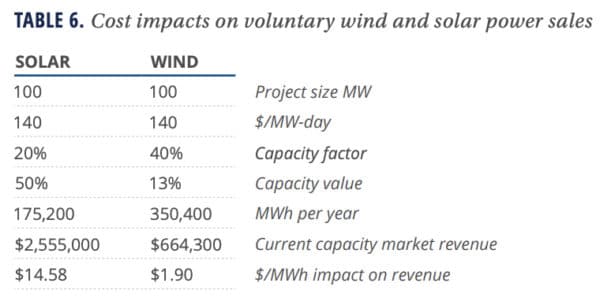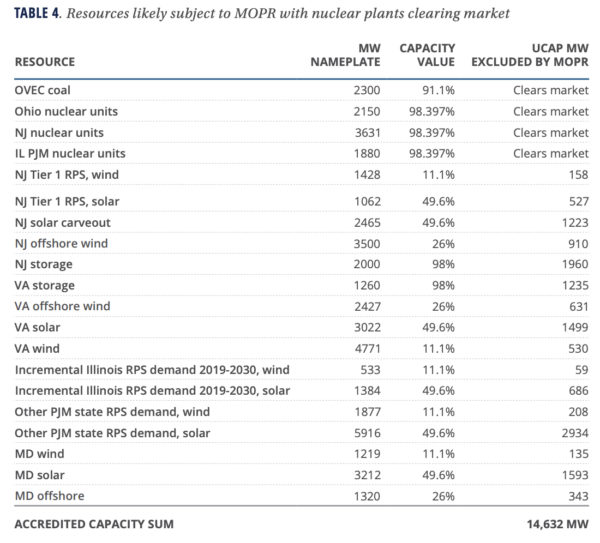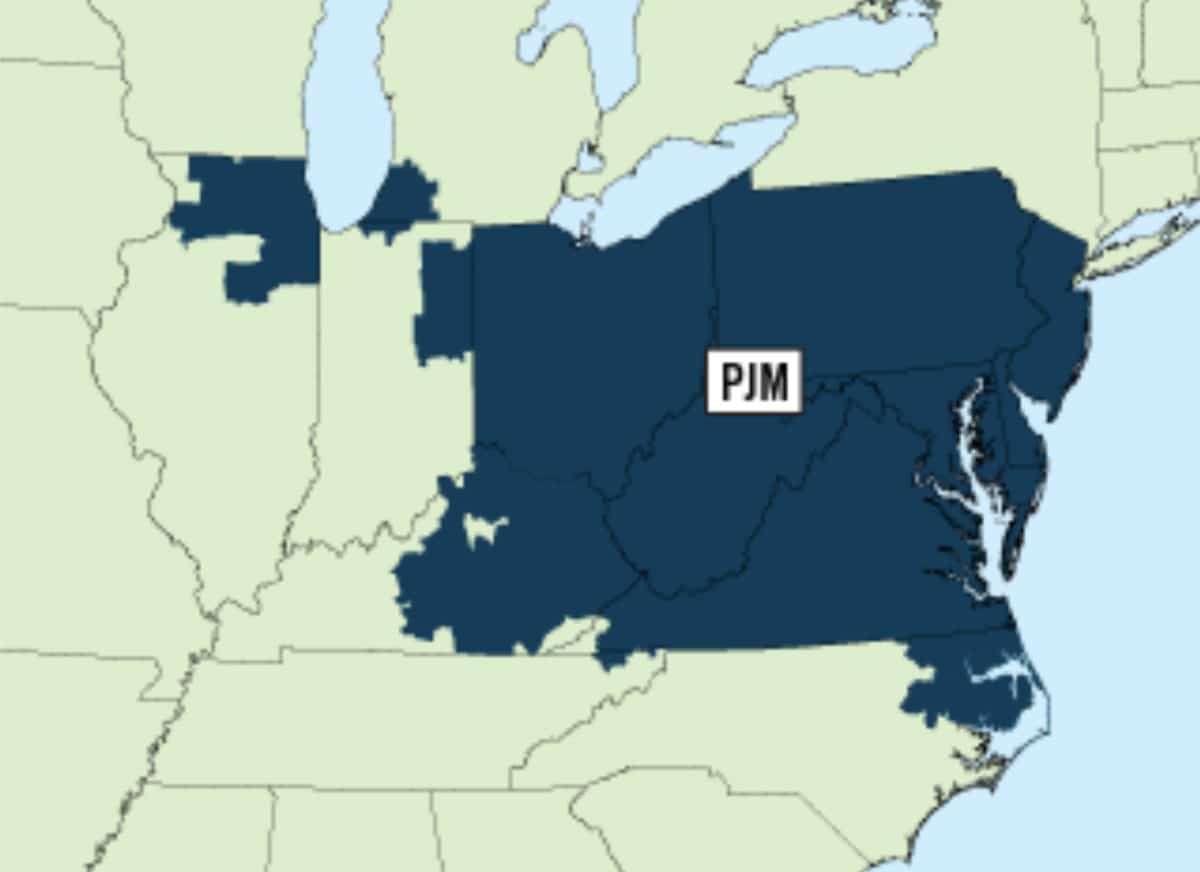Owners of solar installations in the 13-state PJM grid region would be essentially excluded from earning revenue in the PJM capacity market under a new federal Minimum Offer Price Rule (MOPR), a new report shows. That’s because the minimum bids they would be allowed to offer would generally exceed the clearing price in the market.
The rule will exclude projected new solar developments from selling at least 8.5 GW of capacity in the PJM capacity market through 2030, says the report by Grid Strategies, a consulting firm. When counting wind and storage capacity as well, sales of at least 14.6 GW of capacity will be excluded in PJM.
Because a solar, wind, or storage project’s capacity value is less than its nameplate capacity, those capacity values represent a fraction of the 46.6 GW of nameplate capacity of renewable and storage resources that the report says will be needed in the PJM region by 2030, to meet state requirements for renewables and storage.
Without that lower-cost renewable and storage capacity, PJM’s market clearing price for capacity will increase, costing electricity consumers at least $1.1 billion per year, the report estimates. That estimate assumes that nuclear units are allowed to bid low enough to sell capacity, under PJM’s most recent minimum bid levels for nuclear units.
PJM’s website explains that the capacity market enables utilities to procure “the appropriate amount of power supply resources needed to meet predicted energy demand three years in the future.” The owner of a resource that has sold capacity, it says, “must deliver on demand during system emergencies or owe a significant payment for non-performance.”
The Grid Strategies analysis calculated that the average capacity value for solar projects with signed construction service agreements in the PJM interconnection queue is 49.6% of the solar project’s nameplate capacity. The report notes that PJM “is currently revising the method for calculating the capacity value for wind and solar projects.”
Higher-cost solar PPAs
 New solar projects unable to sell capacity will lose an estimated $14.58 per MWh, according to the report’s analysis shown at right. “With some recent solar power purchase agreements in the PJM region being signed at around $30/MWh,” says the report, “the MOPR could impose a 50% increase in the cost of a corporate solar power purchase agreement.”
New solar projects unable to sell capacity will lose an estimated $14.58 per MWh, according to the report’s analysis shown at right. “With some recent solar power purchase agreements in the PJM region being signed at around $30/MWh,” says the report, “the MOPR could impose a 50% increase in the cost of a corporate solar power purchase agreement.”
“No jurisdiction”
Arguing that the Federal Energy Regulatory Commission (FERC), which issued the MOPR rule, lacks the economic policy basis for the rule, the report says “More states are enacting policies with increasingly ambitious targets for carbon-free resources, in part due to the lack of federal action on greenhouse gas emissions. FERC has no jurisdiction over these state policies, so it has resorted to a price penalty for states that pursue them.”
At this point, “courts need to determine whether [the MOPR rule] should be rejected because it is arbitrary and capricious,” says the report.
Grid Strategies previously prepared a report concluding that resource adequacy goals can be better met through means other than capacity markets, as it found capacity markets to be costly and biased against renewables.
Solar excluded
The following table shows how coal and nuclear resources would clear the PJM capacity market, and renewable and storage resources would not. The table is based on the average of PJM’s most recently filed minimum bid levels, or $175/MW-day for solar PV with tracking, and $367/MW-day for solar PV without tracking. Those values are the average of PJM’s minimum bid levels for each PJM zone.

Finer points
Several factors could affect the industry impact and consumer costs of MOPR, the report says, including “what FERC ultimately decides” about PJM’s latest proposed minimum bid levels. Another factor is the extent to which renewable resources will be able to qualify for a lower bid floor, which a resource owner may request by providing PJM “documentation of its actual costs and performance,” the report notes.
FERC also applies “a form of MOPR” in the New York and New England grid regions, and has “expanded” the MOPR rules in the New York region (NYISO), said Grid Strategies President Rob Gramlich, a co-author of the report. A FERC press release said the New York rules are “improving the buyer-side market power mitigation rules.” Gramlich said FERC “has not said whether it would expand” MOPR rules in New England (ISO-NE).
Michael Goggin and Rob Gramlich of Grid Strategies wrote the 20-page report, titled “A Moving Target.” Renewables developer Pattern Energy provided funding.
This content is protected by copyright and may not be reused. If you want to cooperate with us and would like to reuse some of our content, please contact: editors@pv-magazine.com.








The complaint, non-fueled generation (like) solar PV and wind generation are intermittent, so the biased assumption, “we” need fueled generation available at all times to take over the grid from intermittent renewables. The fallacy is the rote ignorance and exclusion of very large scale Energy Storage System distributed along the grid to “accept” non-fueled over generation, during the day for solar PV and perhaps at night for wind generation.
By using power blocks of electronically switched battery storage systems could be designed to series and parallel power blocks to “form” variable generation and hours of generation available from 4 hours to 40 hours depending on the load demand from the grid. We see advertised by entities like AES, Siemens, Fluence large utility scale power storage facilities that are wired to be 100MW/400MWh, but could be broken into smaller entities and “formed” on the fly into series and parallel power units that could generate 50MWh for 8 hours, 10MWh for 40 hours. Use many of these power blocks and create matrices of energy and generation times from one large unit. This, depending on the size of the energy storage facility could become the replacement of what is today the Peaker plant or the spinning demand or spinning reserve fueled generation facility operation.